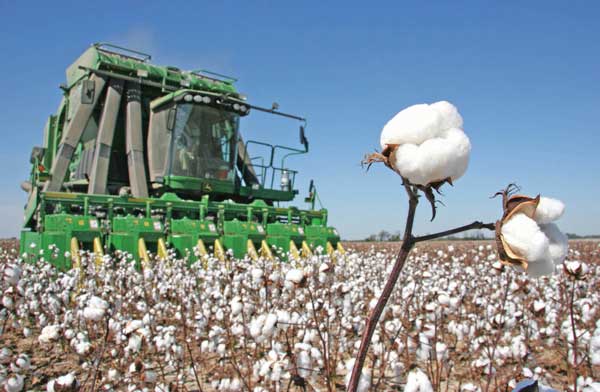
The big pile of cotton that China's government is holding in reserve has long been pressuring cotton prices.But the market has been encouraged lately because Chinese textile mills are importing cheap yarn rather than buying it from its domestic spinning mills.Where are the yarn exporters getting their raw cotton? From the United States.

While China’s huge reserve of cotton is applying negative pressure to cotton prices, world yarn production outside of China is pushing them higher, say market analysts speaking at the Ag Market Network’s January conference call. The panel spoke about cotton fundamentals following USDA’s Jan. 11 World Agricultural Supply and Demand Estimates.
World cotton fundamentals for 2012-13 were bearish on the surface, with increasing world production and lower consumption. Also bearish were estimated world ending stocks, which reached an all-time high of 82 million bales, up 2 million from last month. USDA estimated world production at around 119 million bales and consumption at 106 million bales.
China is hanging on to about half of the world’s ending stocks, noted O.A. Cleveland, professor emeritus, Mississippi State University, and no one is exactly sure of how it plans to dispose of them.
“The Chinese have bought something around 25 million to 26 million bales directly from its cotton producers. They’re paying their cotton farmers directly for their cotton.”
It’s a policy that Chinese decision makers are starting to question, said Cleveland, noting that the government’s investment in the pile of cotton is about $32 billion.
Cleveland says that the Chinese “are finally beginning to reduce their stocks, selling them to the mills at somewhere around a $1.35 to $1.38 a pound.”
However, Chinese textile mills can import cotton for about $1.19, which puts them at a competitive disadvantage if they have to turn to domestic cotton. “As a consequence, the Chinese textile industry is importing yarn rather than buying from spinners,” Cleveland said.
This has been a positive for U.S. exports, Cleveland said. “The yarn is coming from other Asian countries, including India and Pakistan. While Chinese consumption is down a little bit from last year in the spinning mills, yarn imports are up considerably. This implies exports from the United States to the countries that sell yarn to the Chinese. Large volumes of yarn have led to a significant increase in demand for U.S. cotton.”
This was reflected in USDA increasing U.S. exports from 11.8 million bales to 12.2 million bales for 2012-13, a 400,000 bales increase in just one month. “Consumption is an extremely bright light because it’s coming completely from exports, which were supposed to be lagging.
“I would suggest that USDA has another 400,000 bales to 600,000 bales to go,” Cleveland said. “Exports will probably end up somewhere around 12.6 million to 12.8 million bales. That’s a huge jump from where we are right now. Most countries are fairly uncovered with respect to their mill needs.”
Cotton prices have room to move higher, but not significantly, according to Cleveland. “The big question is what China will do with the large reserve of cotton stocks on hand. I think it’s clear from Chinese policy that they haven’t decided what to do. But they have over $30 billion invested in the stocks that they’ve bought. We don’t see any reason why they would dump that cotton on the market. They dump the cotton on the market and they will destroy their investment.”
Carl Anderson, Extension professor emeritus, Texas A&M University, says the surging yarn sales “are the underlying force in the market. One reason why the market is strong is because two-thirds of the global use of cotton is taking place outside of China.”
Anderson says China’s huge stocks will keep the market “from going to extreme highs. So we’re dealing with a market that wants to move sideways 5 cents to 8 cents. It’s a market that’s quite different from a year ago, when we had such a big move from high prices to low prices in the first half of the year.”
Anderson sees a range for old crop cotton in the low 70s to high 70s, and 75 cents to 85 cents for new crop cotton. “Based on the information we’re seeing now, we’re looking at a market that is not likely to go above 89 cents, or drop below 69 cents for the crop that were going to plant.”
Cleveland sees excellent support for old crop at 77 cents to 79 cents a pound. “A month to six weeks from now, we could push it into the very low 80s. In new crop, I would start pricing at 79 cents to 79.5 cents. I’m uncomfortable getting above the high 80s, because of the Chinese stocks. I don’t think the Chinese stocks are bearish on this market. They are put away. They are not available. The Chinese have far too much invested, and they have worked for three years to push cotton prices high. I’m comfortable with the mid-80s in new crop.”
About the Author(s)
You May Also Like





